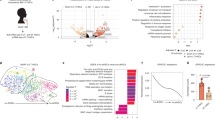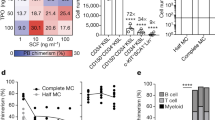Abstract
The proliferation and development of haemopoietic stem cells takes place in close association with marrow stromal cells1,2. This intimate cell contact presumably enables the stem cells and their progeny to respond to stimuli present on the stromal cell surface. While the nature of these stimuli has not been determined, it is likely that growth factors play some role. Recently, it was demonstrated that the natural and the recombinant haemopoietic growth factor, granulocyte/macrophage colony stimulating factor (GM-CSF), could be adsorbed out of solution by an extract of human marrow stromal extracellular matrix (ECM) with retention of biological activity3. However, the precise ECM molecules involved were not identified. Here, we clearly demonstrate that the major sulphated glycosaminoglycan of mouse marrow stroma, heparan sulphate4, possesses the ability to adsorb both GM-CSF and the multilineage haemopoietic growth factor, Interleukin 3 (IL-3). Furthermore, these growth factors, once bound, can be presented in the biologically active form to haemopoietic cells.
This is a preview of subscription content, access via your institution
Access options
Subscribe to this journal
Receive 51 print issues and online access
$199.00 per year
only $3.90 per issue
Buy this article
- Purchase on Springer Link
- Instant access to full article PDF
Prices may be subject to local taxes which are calculated during checkout
Similar content being viewed by others
References
Dexter, T. M., Spooncer, E., Schofield, R., Lord, B. I. & Simmons, P. Blood Cells 10, 315–339 (1984).
Bentley, S. A. Exp. Haematol 9, 308–312 (1981).
Gordon, M. Y., Riley, G. P., Watt, S. M. & Greaves, M. F. Nature 326, 403–405 (1987).
Gallagher, J. T., Spooncer, E. S. & Dexter, T. M. J. cell Sci. 63, 155–171 (1983).
Spooncer, E., Heyworth, C. M., Dunn, A. & Dexter, T. M. Differentiation 111–118 (1986).
Kleinman, H. K. et al. Biochemistry 132, 312–318 (1986).
Roberts, R. A. et al. J. cell Physiol. 132, 203–214 (1987).
Tang, P. W., Gooi, H. C., Hardy, M., Lee, V. C. & Feizi, T. Biochem. Res. Commun. 132, 474–480 (1985).
Dexter, T. M., Simmons, P., Purnell, R. A., Spooncer, E. & Schofield, R. Aplastic Anaemia; Stem Cell Biology and Advances in Treatment (eds Young, N. S., Levine, A. & Humphries, R. K.) 13–33 (Liss, New York, 1984).
Zuckerman, K. S. & Wicha, M. S. Blood 61, 540–547 (1983).
Todaro, G. & Green, H. J. cell Biol. 17, 229–313 (1983).
Dexter, T. M. J. cell Science 88, 1–6 (1987).
Gallagher, J. T. & Walker, A. Biochem. J. 230, 665–674 (1985).
Gallagher, J. T., Lyon, M. & Steward, W. P. Biochem. J. 236, 313–325 (1986).
Vlodavsky, I., Sullivan, R., Sasse, J., Folkman, J. & Klagsbrun, M. Proc. natn. Acad. Sci. U.S.A. 84, 2292–2296 (1987).
Gospodarowicz, D. & Cheng, J. J. cell Physiol. 128, 475–484 (1986).
Author information
Authors and Affiliations
Rights and permissions
About this article
Cite this article
Roberts, R., Gallagher, J., Spooncer, E. et al. Heparan sulphate bound growth factors: a mechanism for stromal cell mediated haemopoiesis . Nature 332, 376–378 (1988). https://doi.org/10.1038/332376a0
Received:
Accepted:
Issue Date:
DOI: https://doi.org/10.1038/332376a0
This article is cited by
-
Biostimulation effect of platelet-rich fibrin augmented with decellularized bovine pericardium on full-thickness cutaneous wound healing in Donkeys (Equus asinus)
BMC Veterinary Research (2023)
-
Acellular bovine pericardium as a biological dressing for treatment of cutaneous wounds of the distal limb in donkeys (Equus Asinus)
Veterinary Research Communications (2023)
-
Regulation of stem cell fate by HSPGs: implication in hair follicle cycling
npj Regenerative Medicine (2022)
-
Fractones: extracellular matrix niche controlling stem cell fate and growth factor activity in the brain in health and disease
Cellular and Molecular Life Sciences (2016)
-
Stromal cells modulate TCL1 expression, interacting AP-1 components and TCL1-targeting micro-RNAs in chronic lymphocytic leukemia
Leukemia (2012)
Comments
By submitting a comment you agree to abide by our Terms and Community Guidelines. If you find something abusive or that does not comply with our terms or guidelines please flag it as inappropriate.



